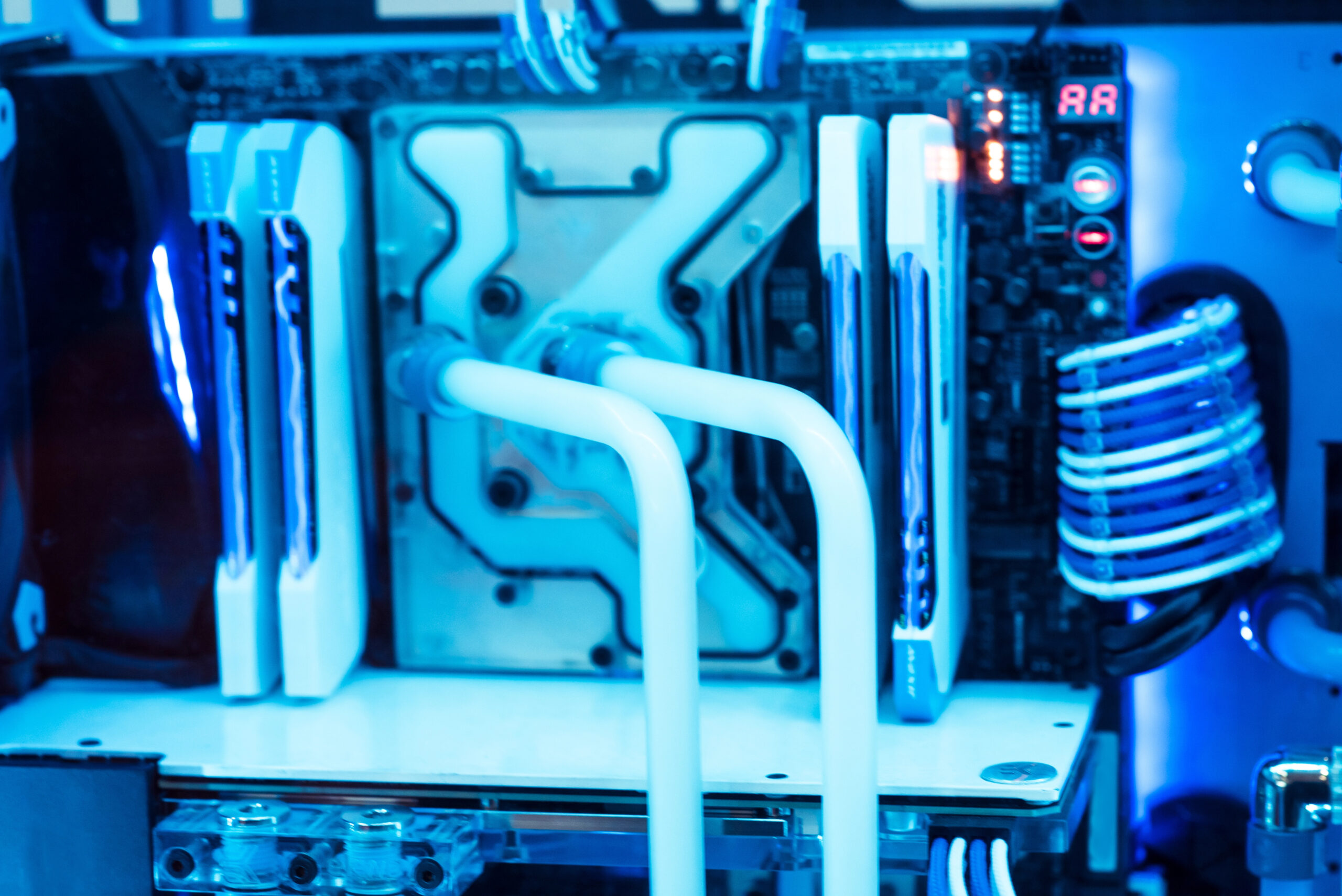If you are seeking solutions to reduce the energy consumption and carbon footprint of your data centers, liquid immersion cooling systems present a promising option. Big tech companies like Tencent have already begun adopting this innovative approach, realizing significant benefits. In this article, we explore the technology behind liquid immersion cooling and the advantages it offers over traditional air cooling.
We discuss case studies and real-world implementations, analyzing the potential energy and cost savings. For data center operators looking to employ cutting-edge techniques to minimize environmental impact, liquid immersion cooling warrants close examination. The following article provides an in-depth look at this emerging solution and its viability to help businesses meet sustainability goals whilst controlling costs.
What Is Liquid Immersion Cooling?
Liquid immersion cooling involves submerging IT components like servers, storage solutions, and networking equipment in a thermally conductive dielectric liquid coolant. The components are fully submerged without risking short circuits as the coolant is non-conductive. As the components generate heat, the temperature of the coolant rises. It is then circulated through an external heat exchanger where it is cooled and re-circulated back into the system.
Improved Energy Efficiency
- Compared to air cooling, liquid immersion cooling can improve energy efficiency by over 50% as water has a much higher heat capacity than air. The dielectric coolant allows for very high heat transfer coefficients, significantly reducing the energy required for cooling. The pumps and other equipment required also consume less energy compared to large CRAC units in air-cooled data centers.
Reduced Carbon Footprint
- The improved energy efficiency of liquid immersion cooling results in a much lower carbon footprint. Some estimates indicate potential carbon footprint reductions of up to 80% compared to traditional air-cooled data centers. The reduced energy usage also lowers operating costs making liquid immersion cooling an attractive option for companies looking to improve sustainability.
Higher Density
- Liquid immersion cooling allows for component densities far beyond what is possible with air cooling. By efficiently removing large amounts of heat, it can enable very high-density server configurations leading to space savings. The smaller footprint reduces costs for data center construction and operations. Some companies have achieved server rack densities of over 100 kW per rack using liquid immersion cooling.
In summary, liquid immersion cooling offers substantial benefits for data centers looking to improve energy efficiency, reduce environmental impact, increase density, and lower costs. Although adoption has been slow, its significant advantages are driving more companies to implement this innovative cooling technique.
Benefits of Liquid Immersion Cooling Systems
1. Improved Energy Efficiency
- Liquid immersion cooling systems are far more energy efficient compared to traditional air cooling methods. Immersing servers in a liquid coolant like dielectric fluid allows for direct contact with and transfer of heat from components. This can improve the heat transfer efficiency by up to 50 times compared to air. The reduced energy required to power cooling translates into lower operating costs for data centers.
2. Higher Power Densities
- Liquid immersion cooling enables higher component densities by removing the need for bulky heat sinks and fans. The dielectric fluid itself acts as a heat sink, allowing components to be packed more closely together. This can increase server density by up to five times compared to air-cooled racks. The increased density reduces the data center footprint and associated capital costs.
3. Noise Reduction
- The lack of fans and pumps in liquid immersion cooling systems results in a nearly silent data center environment. This eliminates the noise pollution associated with the powerful fans required in air-cooled solutions. The noiseless, fanless design is ideal for data centers located close to workspaces or residential areas.
4. Extended Hardware Life
- The stable operating temperatures provided by liquid immersion cooling place less thermal stress on hardware components like CPUs and memory modules. The reduced temperature fluctuations can extend the lifespan of components by up to 50-100%. The prolonged hardware life lowers the total cost of ownership for data center operators through decreased maintenance, repair, and replacement costs.
In summary, liquid immersion cooling solutions offer data center operators substantial benefits through improved energy efficiency, higher server densities, noise reduction, and extended hardware lifespans. The innovative technology enables greener, more cost-effective data center infrastructure.
Case Study: Tencent’s Adoption of Liquid Immersion Cooling
Liquid immersion cooling has emerged as an innovative solution for efficiently cooling high-density servers in data centers. In this method, servers are submerged in a thermally conductive dielectric fluid that removes heat through direct contact with components. The fluid’s high heat capacity allows it to absorb the heat generated by servers and transfer it to a heat exchanger for removal.
1. Reduced Energy Consumption
- By eliminating the need for fans and air conditioning, liquid immersion cooling can significantly reduce energy usage in data centers. Tencent, a major Chinese internet company, adopted liquid immersion cooling for its data centers and was able to reduce energy consumption for cooling by up to 95% compared to air cooling. The improved energy efficiency also results in major cost savings and a lower carbon footprint.
2. Increased Computing Density
- Liquid immersion cooling allows for very high server density since components can be packed more closely together without overheating. Tencent was able to increase computing density in its data centers by a factor of 10 after switching to liquid immersion cooling. The higher density means Tencent can operate more servers in a smaller space, reducing infrastructure costs.
3. Improved Reliability
- The stable operating temperature provided by the dielectric fluid leads to increased reliability and longevity of servers. With liquid immersion cooling, Tencent observed a 50-90% reduction in server failure rates due to overheating as well as a 30% increase in server lifespan. The improved reliability and extended server life help lower operating costs through reduced maintenance and replacement requirements.
Tencent’s successful large-scale deployment of liquid immersion cooling in its data centers demonstrates the significant benefits this innovative technology can provide. By overcoming the challenges of implementation, Tencent was able to radically improve the energy efficiency, computing density, and reliability of its data center operations. Liquid immersion cooling is poised to transform data center cooling and enable continued progress in computing.
Implementing Liquid Immersion Cooling in Your Data Centre

As companies increasingly adopt innovative cooling solutions like liquid immersion cooling in data centers to optimize energy efficiency, it is crucial to carefully evaluate how to implement this technology. When transitioning to liquid immersion cooling, data center managers should consider the following steps:
i. Choose an appropriate liquid coolant
- Select a dielectric coolant specifically designed for immersion cooling of IT equipment. Coolants like mineral oil, synthetic hydrocarbon oil, and fluorinated fluids are popular options. Evaluate factors like cooling efficiency, environmental impact, and cost to determine the optimal coolant for your needs.
ii. Retrofit or build a new facility
- Decide whether to retrofit an existing data center or construct a new facility designed specifically for liquid immersion cooling. A retrofit allows you to leverage existing infrastructure but may require extensive modifications. A new build is more expensive but provides an opportunity to optimally design for immersion cooling from the ground up. Consider your budget, timeline, and data center lifespan when determining the best approach.
iii. Ensure proper containment and ventilation
- The liquid coolant and IT equipment must be fully contained to avoid spills and leaks. Choose a containment tank or enclosure rated specifically for the coolant you have selected. Proper ventilation, fire suppression, and other safety mechanisms are also critical to reduce risk in the event of an overheating component or other issue. Work with experts to install the necessary containment and monitoring equipment to operate the immersion cooling system safely.
iv. Migrate IT equipment and test the system
- Slowly submerge and monitor non-critical IT components to ensure there are no compatibility issues before fully migrating your infrastructure. Once all equipment has been moved into the liquid coolant, thoroughly test the entire system to identify any potential points of failure before putting it into production. Continuous monitoring and maintenance are required to keep an immersion cooling system running efficiently.
With the right strategy and safeguards in place, transitioning to liquid immersion cooling can significantly benefit your data center operations through increased energy efficiency, lower costs, and an improved carbon footprint. However, due to the complexity of the technology, it is not an endeavor to undertake lightly. Do extensive planning and work with industry experts to implement liquid immersion cooling successfully in your facility.
Liquid Immersion Cooling Systems FAQs
1. How do liquid immersion cooling systems work?
Liquid immersion cooling systems submerge IT components like servers in a non-conductive liquid coolant, such as dielectric fluid. The liquid absorbs the heat generated by the components and circulates it to a heat exchanger, which then transfers the heat to a secondary coolant like water. This cooling method is very efficient as liquids have a much higher heat absorption capacity than air.
2. What are the benefits of liquid immersion cooling?
There are several benefits to liquid immersion cooling systems:
- Improved energy efficiency. Liquid cooling requires much less energy to operate compared to air cooling. This can reduce data center energy usage by up to 95%.
- Higher component density. By removing the need for fans and air vents, liquid cooling allows for components to be placed closer together. This reduces the data center footprint.
- Reduced maintenance. Liquid cooling systems have no moving parts like fans, so they require little maintenance. They also help prevent component failures due to overheating.
- Lower noise levels. Liquid cooling operates silently as there are no noisy fans. This improves the working environment for data center staff.
- Increased sustainability. The improved energy efficiency of liquid cooling significantly reduces carbon emissions from data centers. This helps companies meet sustainability targets and improve their environmental credentials.
3. What are the limitations or disadvantages?
While liquid immersion cooling has many benefits, there are some limitations to be aware of:
- Higher upfront costs. Liquid cooling infrastructure requires a major capital investment which can deter some companies. However, energy cost savings often offset these costs over time.
- Added complexity. Liquid cooling systems are more complex to design, install, and maintain compared to traditional air cooling solutions. Specialist expertise and training are required.
- Limited component compatibility. Not all IT components can be submerged in liquid, so liquid cooling may not suit some data center setups. Compatibility also depends on the type of coolant used.
- Additional safety considerations. There are risks of electric shock and chemical spills associated with liquid coolants that require special precautions and monitoring. Proper guidelines must be followed to ensure safe operation.
- Space constraints. Liquid cooling systems require dedicated space for pumps, pipes, heat exchangers, and coolant which can be difficult to accommodate in some data centers. Careful planning of the layout is important.
In summary, while liquid immersion cooling is an innovative solution with significant efficiency and sustainability benefits, companies must weigh these benefits against the potential limitations and challenges involved in its adoption. With proper implementation and management, liquid cooling can be a viable option for data centers looking to reduce their environmental impact.
What’s The Verdict?
Looking ahead, the adoption of liquid immersion cooling systems marks a significant milestone in data center energy efficiency. As this innovative technology becomes more widely implemented, companies have a real opportunity to dramatically cut electricity use and carbon emissions. By being an early adopter, you can gain both financial and reputational benefits, while making a meaningful contribution to environmental sustainability. With careful planning and execution, migrating to liquid cooling could prove to be one of the most impactful green technology investments your organization can make this decade. The potential is certainly there; forward-thinking leaders just need to seize it.
More Stories
Mumbai’s Digital Pivot: Bollywood IT Park Becomes NTT’s Data Center Powerhouse
Recently, NTT Global Data Centers & Cloud Infrastructure India made a notable ₹855 crore acquisition. It purchased the Bollywood, Balaji IT Park from the iconic Kapoor family.
Thailand’s Hyperscale Leap: Digital Edge and B.Grimm Unite for Sustainable Data Center Growth
Digital Edge & B.Grimm Power partnered up to develop a hyperscale data center campus in the Eastern Economic Corridor.
Amazon’s Bold $150 Billion Drive to Expand AI-Powered Data Centers
Amazon has embarked on an audacious journey, committing a staggering $150 billion over the next 15 years to expand its AI-powered data centers worldwide.
KT Cloud Accelerates Digital Growth with New High-Tech Data Center in Yecheon-Gun
KT Cloud new data center in Yecheon-gun marks a key public-private effort with Gyeongsangbuk-do and Yecheon County.
NVIDIA Powers Up: Revolutionizing AI Data Centers with 800V HVDC Systems
NVIDIA emerges as a pioneer, revolutionizing the backbone of AI data centers through its cutting-edge 800V high-voltage direct current (HVDC) systems.
Next-Gen Xeon 6 CPUs Elevate Data Center AI Workloads in Nvidia DGX B300
In the rapidly evolving landscape of artificial intelligence, staying ahead requires cutting-edge technology that can efficiently handle complex workloads. You...


